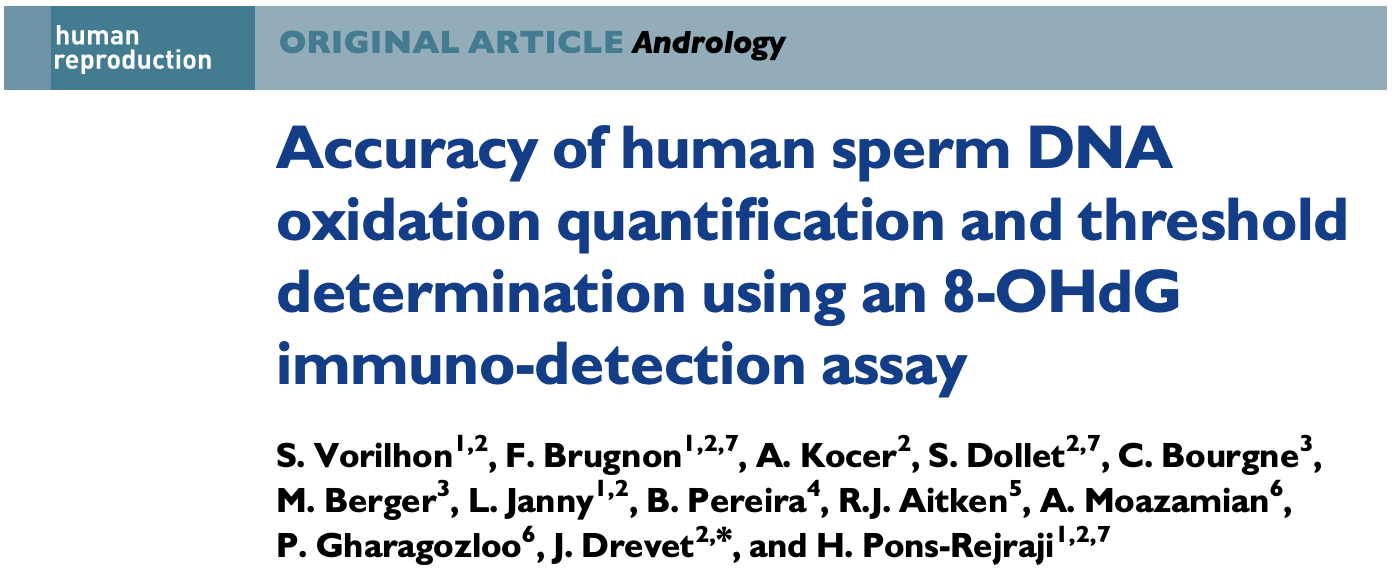Accuracy of human sperm DNA oxidation quantification and threshold determination using an 8-OHdG immuno-detection assay
Vorilhon S et al. – Hum Reprod. 2018 Apr 1;33(4):553-562. doi: 10.1093/humrep/dey038
Of factors contributing to sperm DNA damage, oxidative stress is recognized as one of the major contributing causes to sperm cell dysfunction. Caused by elevated levels of intracellular reactive oxygen species (ROS), oxidative stress is known to damage sperm DNA and has been associated with sperm quality and fertilizing capacity. Oxidative DNA damage refers to various types of functional or structural changes due to the reaction of ROS with DNA; the formation of 8-hydroxydeoxyguanosine (8-OHdG) is widely considered as a key biomarker of oxidative DNA damage and plays an important role in the pathogenesis of many diseases. Still, current clinical diagnostic methods do not include the routine determination of oxidative DNA damage in spermatozoa, partly due to a lack of optimized consensus protocols and clinically relevant thresholds.
The group of Prof. Hanae Pons-Rejraji from the University Hospital of Clermont-Ferrand (France) has addressed this topic in a recent publication. In this article, they showed the validation of a protocol to determine a discriminant threshold for human sperm DNA oxidation using 8-OHdG. This is especially important as it provides a novel validated tool in the diagnosis of male factor infertility associated with oxidative stress.
In this study, samples from 80 men (age 35 ± 1 years: mean ± SEM) undergoing routine semen analysis were evaluated to determine sperm DNA oxidation. Two strategies were applied to validate the protocol. First, three immuno-detection methods including immunocytochemistry, fluorescence microscopy and flow cytometry using the same anti-8-OHdG primary antibody were compared to determine the most relevant and efficient way of assessing human sperm 8-OHdG content. Thereafter, DNA oxidation relative to semen parameters and clinical conditions was compared between the flow cytometry protocol and the commercial OxyDNA Test®.
During the validation, the flow cytometry protocol showed the highest sensitivity and specificity with significant positive Pearson and Spearman correlations for clinical parameters such as BMI, necrozoospermia, asthenozoospermia, teratozoospermia, and leukocytospermia. Compared to the other immune-detection protocols and the commercial kit, the flow cytometry assessment proved to be the most discriminating method regarding assay repeatability, specificity, sensitivity, stability and reliability for sperm parameter alterations. Besides these findings, this method was also able to discriminate pathological sperm DNA oxidation in subjects that were classified as normozoospermic. To define the optimal threshold and predict a pathological state the authors first adapted the ROC-curve method, followed by evaluation of the biological and clinical relevance. These usual inferential analyses were followed by factorial analysis, such as principal component analysis and factor discriminant analysis.
A limitation of the study was that, even though spermatozoa concentration was accounted for within the statistical analysis, samples of oligozoospermic men could not be evaluated due to insufficient material. This would be very interesting for future analyses and the evaluation of this method within a clinical context. Moreover, a comparison of the sperm DNA oxidation with blood parameters for oxidative stress will give insight into the relation of systemic against local stress responses.
Even though within the current study a significant correlation between sperm DNA oxidation and male fecundity was not observed, it will be of interest to study how sperm DNA oxidation relates to pathological sperm conditions, fertilization potential, embryo development, and the offspring’s future health.

